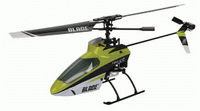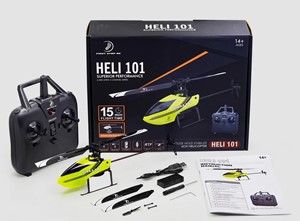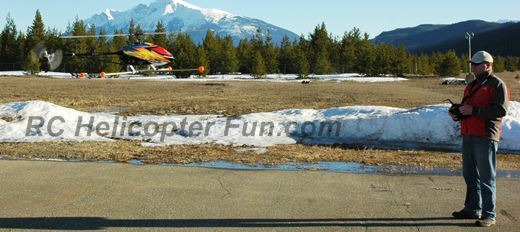Collective Pitch vs. Fixed Pitch RC Helicopters
Which is best for you?
by John Salt - Last Updated January 2025
Another fun RC heli topic to cover: Collective pitch (CP) and how it differs from fixed pitch (FP). Pros & cons of both, and most importantly, why you might consider one over the other.
By the way, to make CP sound even more exciting than it already is, marketing uses the term 3D to describe CP helicopters. This is technically incorrect. 3D is a flying style, not a helicopter type!
Anyway, like you, I was also faced with this choice when first getting into the hobby. I decided right off the bat to get into collective pitch. But just because I went that route, doesn't mean you should as well.
Before going any further, do you have a fairly good understanding what rotor blade pitch is, and how it relates to lift on all helicopters? If not, you may want to check out the page I have on lift as it will give you all the basics you need to understand the topics on this page.
If you do have a good grasp on how lift is generated by RC helicopter rotor blades, great! Let's get right to it...
Fixed Pitch RC Helicopters
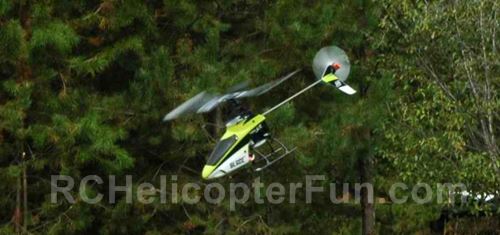 Fixed Pitch Flying Can Still Be Very Enjoyable
Fixed Pitch Flying Can Still Be Very EnjoyableFixed Pitch (FP) is exactly that. The pitch of the main rotor blades are held at a fixed or constant angle of attack.
You control the amount of lift to your helicopter by simply varying the speed of the engine/motor.
If you increase the speed of the motor, the rotor blades turn faster and produce more lift. The reverse happens when you lower the speed of the motor.
This is a very simple means of controlling the amount of lift to your RC helicopter and if you just want a very simple and inexpensive model heli, this method of controlling lift does work. Parts count is also down substantially on FP helicopters.
These are the main reasons fixed pitch is generally what most people start out with. Simplicity and cost!
Fixed pitch helis are also generally more stable in a hover (in no wind) due to the shape of the high lift rotors, the lower speed at which they spin, and auto-level electronic stabilization on many small fixed pitch RC helicopters these days.
Drawbacks To Fixed Pitch Lift Control
Newton's 1st law of motion pretty much sums up the main draw back to fixed pitch RC helicopters:
Object's in motion tend to stay in motion, and objects at rest tend to stay at rest.
First off, motors and/or engines, can't just speed up and slow down instantaneously when you give them a command to do so. There is inertia to overcome.
The mass of the rotor blades and rotor mechanism compound this problem as the engine or electric motor has to overcome the inertia to get the rotor spinning faster or the kinetic energy stored in the rotor assembly to slow it down.
In other words, that's why there are no fairly large fixed pitch RC helicopters out there anymore.
In my early RC heli days (the late 80's), 30/550 size fixed pitch nitro helis were actually fairly common. They were a bear to hold at a fixed altitude because you were always behind the eight ball of what the heli was doing due to the rotor RPM speed change delays. Not to mention tail blow out would occur almost every time you had to give a moderate speed correction to the main rotor.
This is why I chose collective pitch to start on because I had seen just how bad these larger fixed pitch RC helicopters behaved at the flying club. That was of course before there were small micro fixed pitch RC helicopters like we have today.
All fixed pitch RC helicopters now are micro size; and as a result of having much less heli and blade mass, fixed pitch can work very well with these little rascals.
The Heli C129 / 101 for example is a very popular choice and is one of the best fixed pitch RC helicopters to first start & learn on; especially if you don't want to spend too much money to find out if you even like this hobby.
Fixed pitch works fairly well on RC helicopters that have main rotor diameters up to about 12 inches (300mm) or so. After that, the rotor and helicopter mass starts getting to be too much, and fine lift control is lost because of the delay in rotor speed changes.
Tail blow out tendencies (where the tail rotor loses its fight against the main rotor torque) also starts to become a big problem on fixed pitch birds this size and larger.
The torque spikes are not only greater, but so is the severity in how much they change every time you adjust the speed of the rotors to control your lift. This all adds up to a very hard working tail rotor that is being pushed to the extremes to hopefully keep the heli from yawing.
Poor wind handling immunity is another limitation with fixed pitch RC helicopters. Most fixed pitch helis have a very hard time when the wind picks up because the rotor speed is so slow compared to collective pitch helicopters. This can result in being lofted up high in the air when even a small gust of wind hits your bird. Slow and changing rotor speed can also give poor cyclic performance.
With all that said, here's a neat little fixed pitch heli I recently reviewed that actually handles wind fairly well. It deals with the tail blow out issues by keeping the rotors spooled at low stick. This would have to be the best performing fixed pitch RC helicopter I've flown to date, but it's still no where near as good as collective pitch. The test flight begins @ 14:27 into the video.
Collective Pitch RC Helicopters
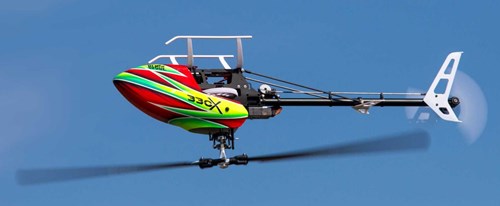 Collective Pitch RC Helicopter Hovering Inverted
Collective Pitch RC Helicopter Hovering InvertedFrom aerobatic 3D to scale, big turbine to small micro sizes; collective pitch (CP) RC helicopters are the ultimate expression of fun & achievement in our hobby.
They are what most people aspire towards. They are challenging and immensely rewarding; rarely will they ever get boring!
So why is collective pitch so challenging?
CP helicopters (model and full size) are not positively stable; meaning they are unstable, especially while hovering.
Hovering a collective pitch RC heli is similar to balancing on a big ball. This is why the collective pitch RC chopper is more difficult than other RC vehicles.
You are constantly making multiple control corrections simultaneously to keep a heli stationary, in a state of hover equilibrium.
I call this "active piloting".
This might make you ask "how on earth can that be fun or rewarding, this guy must be as unstable as his helicopter!" Certainly not far off the mark...
Joking aside, these constant & multiple control corrections connect you to your collective pitch helicopter like no other RC vehicle. You're totally focused and "immersed in the moment."
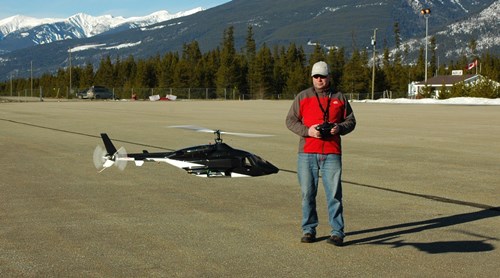 Immersed In The Moment -Flying A Collective Pitch RC Helicopter
Immersed In The Moment -Flying A Collective Pitch RC HelicopterWith collective pitch (CP), the pitch or angle of attack of the main rotor blades changes to control lift while the motor/engine speed and rotor speed stays more or less constant.
This time when you want to gain altitude, you increase the collective angle of the rotor blades, and your helicopter starts lifting almost instantaneously with no lag time.
To stop the rate of climb, you decrease the pitch of the rotor blades and again, the response of the helicopter is almost immediate. It takes only very small movements of the rotor blade pitch angle to achieve these instantaneous corrections and gives you very precise & immediate control of your RC helicopter's lift component.
On full size and larger RC helicopters, this is the ONLY way to control lift and I can't think of one single rotor RC heli these days with a rotor diameter over 600mm (about 2 feet) that is fixed pitch any more.
With a fairly constant rotor RPM, cyclic control is also much more consistent and the heli doesn't suffer from changing torque spikes as much meaning the tail rotor doesn't have to work as hard and is much less likely to blow out.
Collective Pitch rotor RPM is higher than with fixed pitch (comparing the same size helicopters) and as I mentioned, that gives much better wind handling immunity not to mention much faster flight performance. The other big benefit with CP is it allows inverted flying by allowing the pilot to produce negative pitch while upside down, thereby still creating positive lift.
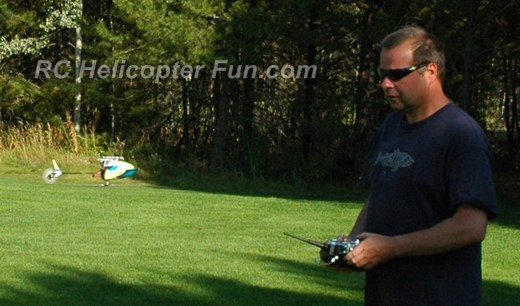 Inverted Fun
Inverted FunHere's a video I made that goes over how inverted flight is accomplished thanks to collective.
Please don't dismiss collective pitch because it seems hard or even impossible at first. Think back to when you were first learning to ride a bicycle; one of the most exciting and fun things most of us can remember from our childhood - same idea here (less the scraped knees and elbows).
Also like riding a bicycle, once you learn how to hover a collective pitch radio controlled helicopter, you'll never forget! I still remember the day I had my first successful hover many years ago. It was an amazing feeling and experience. The continuous control corrections become second nature, you don’t even realize you're doing them (subconscious/muscle memory).
After trying and trying with short little hops off the ground, which slowly become longer and longer in duration, something clicks.
Your brain gets it and you are immersed in RC euphoria as you see your helicopter hanging in the air under your full control.
You're on cloud 9 for days. You have to keep flying & practicing, getting better and better.
Every day you go out flying, you can't wait to get back out flying again to chase that sensation. To think... "I'm actually hovering & flying this thing around under my full control!" It's a feeling & sensation that's hard to describe; but it's something most of us experience with every one of our collective pitch RC helicopters.
A natural high occurs and yes, you are usually addicted to the hobby at this stage :-)
The Drawbacks of Collective Pitch
There are of course a few downsides to CP, the main two being the increase in cost and mechanical complexity. That said, some of today's micro collective pitch helicopters are actually not that much more expensive than what some fixed pitched birds cost.
Collective pitch heli setup is another complexity and one of the main reasons many beginners new to the hobby start out on fixed pitch because you don't have to learn nearly as much.
The other main downside is collective pitch is harder to learn how to fly because all CP heli's are unstable while hovering. Once flying fast however, they are solid as a rock.
My page titled Are RC Helicopters Hard To Fly covers this in much more detail and is worth taking a peek at if you really want to understand RC helicopter control behavior better.
CP vs. FP Conclusion
To sum up...
- Fixed Pitch is only found on small micro helicopters these days.
- FP costs less than CP.
- FP is best suited to beginners who just want to try flying an RC helicopter to find out if they will even enjoy the hobby.
- FP will get boring for most people.
There are certainly performance limitations, but as a first introduction to RC helicopters, fixed pitch is a viable & workable option.
Collective pitch on the other hand...
- It's what full size helicopters use.
- CP gives the RC helicopter pilot the ability to fly not only faster and in greater control, but also allow inverted flight.
- CP has the ability
to fly in much windier conditions.
- CP has a longer learning curve, but it rarely gets boring!

